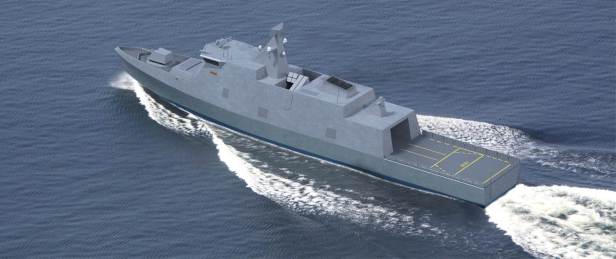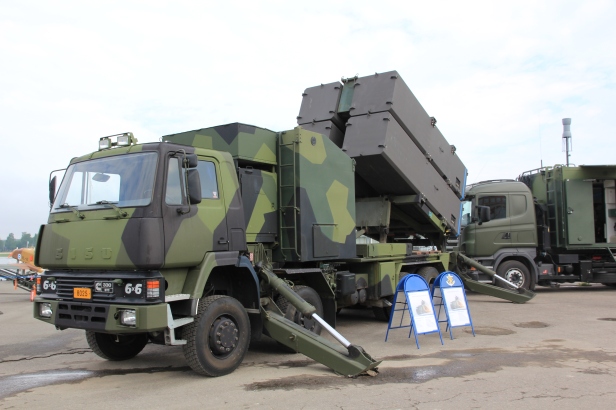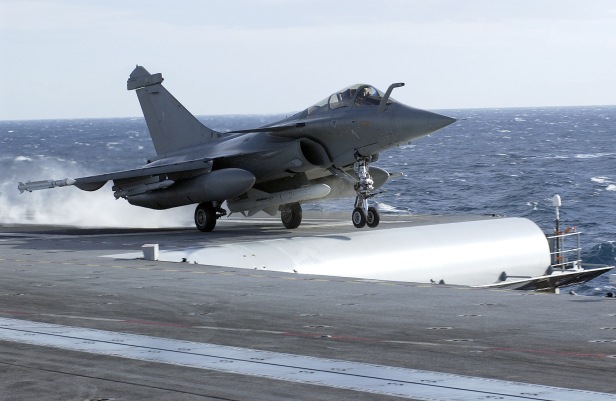The main anti-ship weapon in the current Finnish arsenal is the MTO 85M long-range anti-ship missile. This is a version of the widespread Saab RBS15 surface-to-surface missile named RBS15 SF-III (often this designation “Third version of the RBS15 for Suomi/Finland” is mixed up with the RBS15 Mk3 designation, which denotes a newer version, more on this below).
The MTO 85M is found on both the Rauma- and Hamina-class FAC, as well as on truck-mounted batteries firing from land. Notably, Finland has not acquired the air-launched version of the missile. The MTO 85M with its 100 km range make up the outer ring of defence against enemy surface units, and is then backed up with the 130 TK turret-mounted coastal guns firing 130 mm anti-ship grenades at ranges over 30 km and short-range RO2006 (Eurospike-ER) missiles being carried by infantry squads. The short range of the latter, around 8 km maximum, is made up for by the fact that the infantry squads are extremely small and mobile, and as such can move around in the archipelago to set up ambushes at choke points or guard minefields from being swept. However, when push comes to shove, it will be the MTO 85M that will have to do much of the heavy lifting.

The joker of the pack is the NSM provided by Kongsberg, and selected (in its air-launched JSM-version) to be the prime anti-shipping weapon for the F-35. The Norwegians has a reputable reference in the AGM-119 Penguin, which is a short-ranged IR-seeker missile that has seen significant export sales, crucially as a helicopter-launched weapon to the US Navy. The system was also operated by the Swedish Navy as the Rbs 12. The NSM is altogether different though, and its performance and size places it in the same category as the above-mentioned missiles, with one crucial difference: it uses a passive IIR-seeker, making it worse at handling adverse weather conditions but potentially better at coping with modern countermeasures which have heavily focused on spoofing radar seekers. It might also have an easier time in the cluttered archipelagos of the Finnish coast.

For Finland, a number of pieces are bound to move around within the near future. As mentioned, the RBS15 SF-III is not the RBS15 Mk3 used by Poland, Germany, and Sweden, and will need to be replaced at some point. The system itself celebrated 35 years since the first launch this summer, and while it might sound much, by then both Harpoon and Exocet were already tried and proven systems in service. The important part is that the basic missiles of all three families have been continuously updated, and current versions share little except name and outward appearance with their brethren of the 80’s.

For Finland, the MTO 85M is bound to receive a one-for-one replacement, and not only is it likely to be introduced on the new corvettes, but it is likely that the same missile will be implemented on the Hamina-class following their MLU and to the vehicle-mounted batteries as well. The great question is the third part of what logically would be a triad, namely an air-launched weapon. Currently the Finnish Air Force is in the situation that it feature a naval fighter, but lacks any serious anti-shipping capability. There would be a seemingly simple solution, as while the JASSM has been the flagship of the newfound Finnish air-to-ground capability, another missile has also been introduced: the AGM-154C JSOW. While the missile originally was conceived as a ‘pure’ cruise missile, the latest Block III version (C-1) is able to be used in the anti-shipping role as well. The first JSOW C-1 was test-fired from a F/A-18F Super Hornet earlier this year, and upgrading to this version could provide the Finnish Defence Forces with a diverse anti-shipping capability.
While getting anti-shipping missiles for the Hornet might not be realistic, the talk about giving HX an expanded range of capabilities compared to its predecessor gives some reason for optimism. The question then is should HX be allowed to influence the choice of new AShM?

At first glance, stating that the Navy follow the cues of the Air Force to get what they’re having might seem tempting. However, there are a number of issues with that thought. To begin with, the air- and sea-launched versions not necessarily share enough components and similarities in handling to create any measurable synergies in acquisition or training. The HX and Squadron 2020 timelines are also somewhat conflicting. The main issue is that as HX likely will get a fighter with a missile already integrated, this would create a situation where a secondary weapon system of the Air Force would determine the main striking power of the Navy. While this would equate to putting the cart in front of the horse, the alternative is that Finland would pay for the integration of the Navy’s missile of choice onto the Air Force’s fighter of choice, or that the Navy and Air Force use different weapons. This is not necessarily a bad thing, sporting different weapons makes it harder for the target to know how it should respond to a threat, but the question is if this politically will be a harder sell, regardless of whether it actually is more expensive or not.
An interesting alternative is the launchers recently sold by MBDA to Qatar. The coastal launchers are remarkable in that they can employ both the Exocet MM.40 and the lighter MARTE ER. This could be an interesting solution especially for the upcoming Finnish coastal batteries, where a hi-low missile mix could make room for more reloads while still sticking with a single launcher. The MARTE can also be employed by the NH 90, though in the Finnish case this would probably not be cost effective. To begin with, the TTH version lack a suitable search radar, and would have to rely on outside targeting data. On today’s networked battlefield this isn’t necessarily a big deal, but the bigger issue is the fact that the Army will need every single one of their helicopters for tactical transports.
So, which missile will it be that finds its way onto our new corvettes? Harpoon is slowly on the way out for the US Navy, and while it probably will still see use for the next few decades, adopting it as a new system at this point doesn’t make much sense. The JSM with its IIR-seeker probably won’t make the cut due to its limited all-weather capability, though it could be an interesting complement as an air-launched weapon, and the apparent positive experience with Kongsberg’s NASAMS and the recent acquisition of Patria by Kongsberg might well come into play when discussing this option (especially if the F-35 bags the HX-contract). This leaves the updated RBS15 Mk3 and the Exocet MM40 Block 3. With Saab’s strong position as the current supplier of both the MTO 85M and the 9LV combat management system, they seem like the favourite. Saab has also started the marketing campaign already.



I would not be so quick to discount the NSM. The Norwegians are confident that it will operate well in bad weather and winter weather in the Arctic is nothing to joke about. On top of that is the cooperation with Australia to integrate an ESM sensor to detect and classify radars in addition to the IIR. Given the confined sea room surrounding Finland where threats can appear quickly it is likely that opponents will have their radars lit.
But as a Swede I am of course rooting for you to continue with the Rb-15. 🙂
Ymmärsinkö oikein että Suomi meinaa aseistaa meidän uudet korvetit vanhoilla mti-85?Olin rannikkotykistön meri tulentulenjohtueessa ja johdettiin 130mm tulta kolmella ryhmällä. Yksi lepäsi ja kaksi johti! Sitten yhtenä kauniina päivänä toivat näitä MTO-85 rekanlavalla(kuin kuvassa) kertoivat että kantama on 70km! Ja rautakaulukset hakkasivat rintaansa että nyt on millä iskeä! Mutta kyseistä aselajia ei enää ole edes olemassa. Ja olimme todella armeijan harmaissa eli”hiiva puvussa”. Kuinka paljon juuri kyseisessä jutussakin annoit ymmärtää että vaihtoehtoja on! Mitä jos valtio säästäisi ja kotiuttaisi nykyiset sotilaat ja ottaisivat meidät vanhat äijät laivan kannelle ampumaan pystykorvalla m-39 kaikkea liikkuvaa ja osalle kokardi otsaan!
Ei, oletusarvo on että nykyiset MTO 85M ohjukset ovat jäämässä eläkkeelle, ja niiden sijaan tulisi joko uusi versio samasta ohjuksesta tai jotain ihan muuta.
Ok, olin jo pakkaamassa👍🏻
Keep in mind that Sweden does not have the latest version of RBS 15 and that they are ever so old and outdated nowadays.
A new missile is in the cards and will be fielded in the 2020-2025 timeframe. No word yet if it will be a new version of RBS 15 (likely), a completely new missile pr maybe even a foreign missile (LRASM).
The Mk.III is far from old and outdated. It’s basically a totally new missile compared to the Mk.II even though it uses the same form factor.
It is old and it is getting outdated. These new ships will sail until 2050. They are not gonna supply them with an ASM that is nearing 20 years old when these ships becomes operative. Especially not since Sweden themselves is going for a new missile.
LRASM or NSM have a much bigger chance of being selected rather than the MK.III.
Yesterday USA’s Defense Security Cooperation Agency released a possible Major Arms Sale of Harpoon antiship missiles to Finland: “WASHINGTON, FEB. 5, 2018 – The State Department has made a determination approving a possible Foreign Military Sale to Finland of RGM-84Q-4 Harpoon Block II+ ER Grade B Surface-Launched Missiles and RGM-84L-4 Harpoon Block II Grade B Surface-Launched Missiles for an estimated cost of $622 million.”
http://www.dsca.mil/major-arms-sales/finland-rgm-84q-4-harpoon-block-ii-er-grade-b-surface-launched-missiles-and-rgm-84l